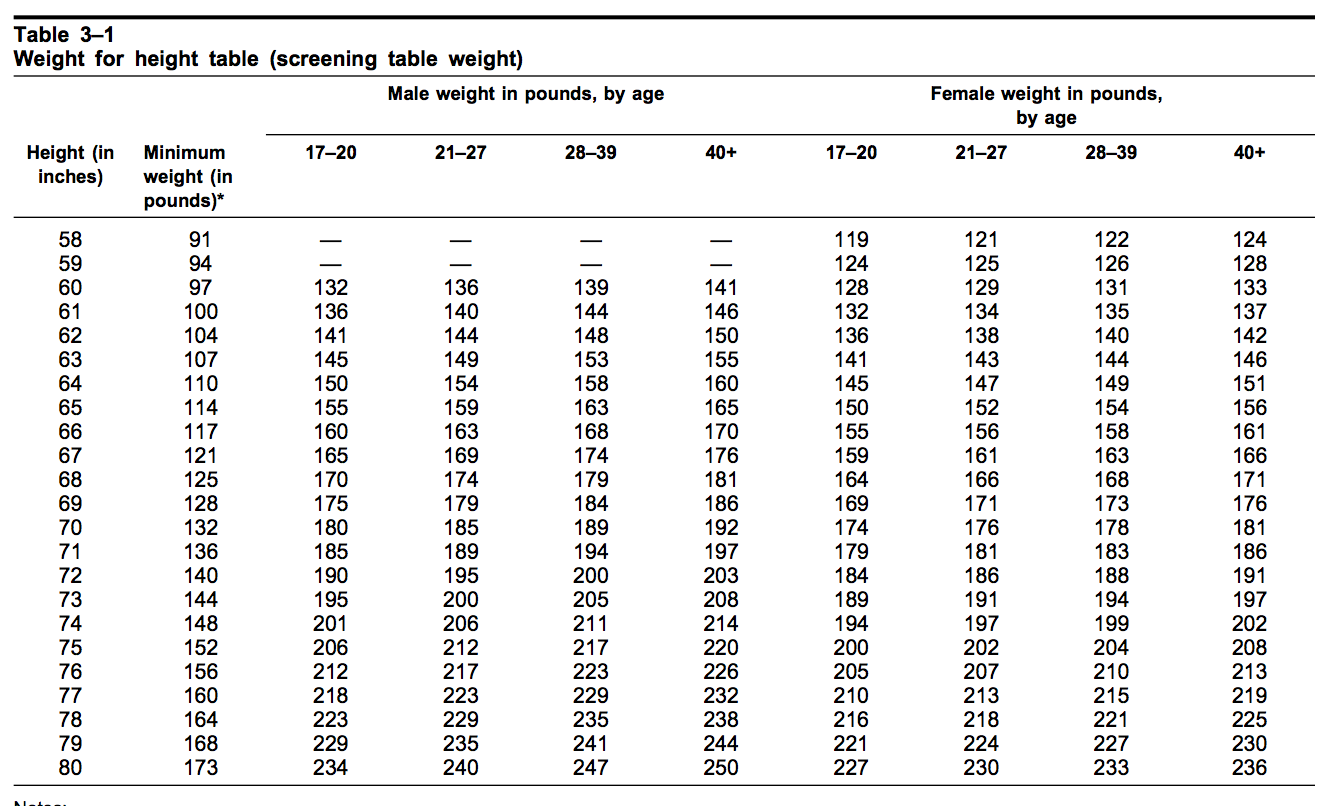The Army height and weight standards for 2024 are crucial for maintaining the physical readiness of soldiers. These standards not only ensure the operational effectiveness of military personnel but also contribute to their overall health and fitness. As we delve into the specifics of these standards, it is essential to understand their significance and the criteria that every soldier must meet to serve effectively in the United States Army.
In this article, we will explore the height and weight requirements set by the Army, the methods used to measure these parameters, and the implications of failing to meet these standards. Whether you are a prospective recruit, a current soldier, or simply someone interested in military fitness, this comprehensive guide will provide you with the necessary insights into the Army's physical standards for 2024.
Moreover, we will discuss the importance of maintaining these standards, the potential consequences for those who do not comply, and tips for soldiers striving to meet the Army's height and weight requirements. By the end of this article, you will have a thorough understanding of Army height and weight standards and how they impact the lives of soldiers.
Table of Contents
- 1. Army Height and Weight Standards for 2024
- 2. Measurement Methods for Height and Weight
- 3. Significance of Height and Weight Standards
- 4. Consequences of Non-Compliance
- 5. Tips for Meeting Height and Weight Standards
- 6. Biography of Army Standards
- 7. Personal Data and Statistics
- 8. Conclusion
1. Army Height and Weight Standards for 2024
The Army height and weight standards for 2024 are designed to ensure that soldiers are physically capable of performing their duties. The following are the general requirements:
- Men: Height between 60 inches (5 feet) and 80 inches (6 feet 8 inches)
- Women: Height between 58 inches (4 feet 10 inches) and 80 inches (6 feet 8 inches)
Weight standards vary based on height and gender. The Army uses a body mass index (BMI) calculation and body fat percentage assessments to determine whether soldiers meet these standards.
2. Measurement Methods for Height and Weight
To accurately assess whether a soldier meets the Army's height and weight standards, specific measurement methods are employed:
2.1 Height Measurement
Height is measured using a stadiometer, ensuring that the soldier stands in a neutral position with their back against the wall. The measurement is taken to the nearest quarter inch.
2.2 Weight Measurement
Weight is measured using a calibrated scale. Soldiers are required to be weighed in the uniform they would normally wear during duty hours.
3. Significance of Height and Weight Standards
The Army height and weight standards are significant for several reasons:
- Ensures Operational Readiness: Soldiers must maintain physical fitness to perform their roles effectively.
- Promotes Health and Well-being: Adhering to these standards encourages soldiers to lead healthier lifestyles.
- Enhances Team Cohesion: Physical fitness contributes to overall morale and teamwork within units.
4. Consequences of Non-Compliance
Failing to meet the Army height and weight standards can have serious consequences, including:
- Entry into the Army Weight Control Program: Soldiers may be required to follow a strict program to lose weight.
- Impact on Promotions: Non-compliance can affect a soldier's chances of being promoted.
- Possible Administrative Actions: Continued failure to meet standards may lead to separation from the Army.
5. Tips for Meeting Height and Weight Standards
For soldiers aiming to meet the Army's height and weight standards, the following tips can be beneficial:
- Maintain a Balanced Diet: Focus on a diet rich in fruits, vegetables, lean proteins, and whole grains.
- Engage in Regular Exercise: Incorporate both cardiovascular and strength-training exercises into your routine.
- Stay Hydrated: Proper hydration is essential for overall health and can aid in weight management.
- Seek Support: Utilize resources available through the Army, such as fitness programs and nutritional counseling.
6. Biography of Army Standards
The Army's height and weight standards have evolved over the years to adapt to the changing needs of military service. Established initially in the early 20th century, these standards have been revised to reflect advancements in health and fitness knowledge.
7. Personal Data and Statistics
Here is a table summarizing the personal data and statistics related to Army height and weight standards:
| Category | Men (lbs) | Women (lbs) |
|---|---|---|
| 60 inches | 140 | 120 |
| 65 inches | 160 | 140 |
| 70 inches | 180 | 160 |
| 75 inches | 200 | 180 |
8. Conclusion
In conclusion, the Army height and weight standards for 2024 are essential for ensuring the physical readiness of soldiers. Meeting these standards is not only crucial for operational effectiveness but also promotes health and overall well-being. Soldiers must remain vigilant in maintaining their fitness levels and seek assistance when needed.
We encourage readers to share their thoughts on this topic, leave comments, and explore more articles on military standards and fitness. Your engagement helps foster a community dedicated to understanding and supporting our servicemen and women.
Thank you for taking the time to read about the Army height and weight standards for 2024. We look forward to your next visit!
FDA Ramen Noodle Recall: Everything You Need To Know
Rebecca J: The Rising Star In The Music Industry
Kevin Surratt Jr. Wife Olivia: A Deep Dive Into Their Relationship


